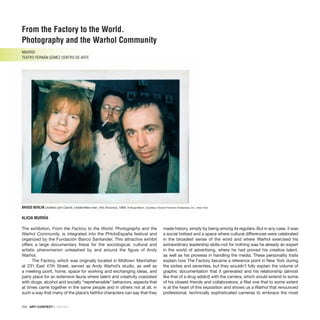El Ranchito en Matadero Madrid es un proyecto participativo que involucra a espacios independientes, creadores y agentes culturales en la programación y toma de decisiones. Se ha constituido como un laboratorio abierto para analizar el contexto local, producir trabajos interdisciplinarios y exponer resultados a través de un proceso integrado. El objetivo es maximizar los recursos limitados en la crisis económica y generar herramientas de resistencia mediante nuevos modelos de cooperación y participación ciudadana.
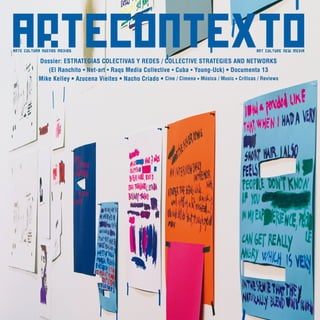




























































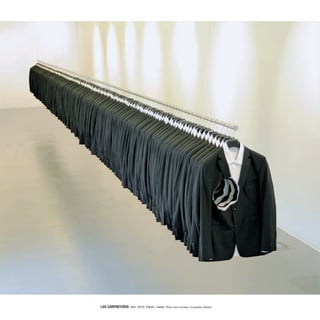























![PÁGINAS CENTRALES / CENTRAL PAGES · ARTECONTEXTO · 87
les sean las posiciones que adoptamos en relación a él, ninguna
aproximación, ningún debate sobre estas cuestiones puede pasar
por alto las obras que se exponen efectivamente en esta Documen-
ta. Porque las mismas no son simples ilustraciones de una teoría
previamente elaborada ni muñecos de ventrílocuo de un sujeto om-
nisciente sino que poseen su propia capacidad de abrirnos vías de
apropiación, interpretación o reinterpretación del mundo, en las que
lo sensible y lo inteligible se aúnan en vez de escindirse sin remedio.
Una concepción que parece compartir Carolyn Christov-Bakargiev
a juzgar por la audaz decisión curatorial de ocupar la legendaria
rotonda del Fridericianum con una instalación titulada The Brain [El
cerebro] que, en vez de exponer medios, instrumentos y resultados
del conocimiento positivo, reúne un conjunto heterogéneo de obje-
tos y de obras de arte de los más diversos estatutos y de las más
disímiles procedencias.
Allí aparece la Princesa bactriana –representada en una serie
de tallas en piedras semipreciosas desenterradas por arqueólogos
en las tierras afganas, que lo fueron del milenario reino de Bactria–
junto a una pequeño desnudo femenino en porcelana guardado
por Adolf Hitler en su piso de Múnich, que fue fotografiado por la
corresponsal de guerra Lee Miller, y cuyo torso desnudo, así como
sus brazos en alto, remiten al autorretrato fotográfico que la propia
Miller se hizo en 1930, igualmente incluido en esta insólita versión de
la enciclopedia china imaginada por Borges. También hay cerámicas
del catalán Antoni Cumella y de la paraguaya Juana Marta Rodas,
y dibujos de Gustav Metzger, Horst Hoheisel, Vyacheslav Akhunov
o Giang Huong junto a restos de piezas fundidas por el fuego
desencadenado en el Museo Nacional de Beirut, durante la atroz
guerra civil librada entre 1975 y 1980. Este inventario tampoco es
exhaustivo y solo quiere poner “en presente” una concepción del
cerebro y de su funcionamiento que elige para su representación
las obras tangibles de la imaginación antes que las abstracciones
lingüísticas o matemáticas. Y que, por lo tanto, otorga al arte un
papel muy relevante.
Pero, quizás, donde el arte, en lo que tiene de producto de la
imaginación liberada, se muestra en esta Documenta de la manera
más potente es en la espléndida instalación audiovisual de William
Kentridge, expuesta en una de las naves situadas en la trasera de
la Hauptbahnhof. Se titula The Refusal of Time y es una obra multi-
media, operística, exorbitante, en la que el rechazo del tiempo y de
De izquierda a derecha:
ADRIÁN VILLAR ROJAS
Return the World, 2012.
Commissioned by dOCUMENTA (13) and
co-produced by kurimanzutto, Mexico City.
Foto: Nils Klinger. Cortesía: el artista.
Roman Ondák
Observations, 1995/2011.
Foto: Anders Sune Berg.
Cortesía: el artista.](https://image.slidesharecdn.com/artecontexton34-35-220304081201/85/Artecontexto-n34-35-87-320.jpg)












![100 · ARTECONTEXTO · PÁGINAS CENTRALES / CENTRAL PAGES
Dirty (1992) del grupo neoyorquino es una de las conoci-
das muñecas de Kelley, pero esta colaboración adoptaría
muchas formas, muy principalmente en una pieza llamada
Platos Cave, Rothko’s Chapel, Lincoln’s Profile, escrita ya en
los años 70 y vagamente basada en la estructura del teatro
kabuki japonés. Esto sucedía en 1986 y se trataba de una
performance realizada en el Artist’s Space de Nueva York.
Esta pieza ya se había llevado a cabo un año antes, pero
Kelley pensaba que funcionaría mejor con música y de él
partió la iniciativa.
Como hemos visto, el trabajo de Mike Kelley mantuvo
a lo largo del tiempo una serie de constantes que explican
su influencia. En primer lugar y frente a la relativamente
sencilla recepción del conceptual neoyorquino, que al fin y
a la postre mantenía una relación semántica con la acade-
mia vanguardista Kelley, como Shaw, McCarthy y Oursler
ofrecían una obra plagada de imágenes fuertes y grotescas
que suponían un corte radical en el entendimiento del arte.
En Kelley la provocación nunca era buscada, o al menos sus
trabajos parecen surgidos de una sinceridad radical. Como
ha dicho tras su muerte el maestro Baldessari: «He was the
best, a bit like Jesus I’ve been thinking» [Era el mejor, he
estado pensando que un poco como Jesús].
Hablan los amigos de Mike Kelley:
Tony Oursler
Una de las cosas que, retrospectivamente, me
han fascinado sobre Mike es que comenzó es-
tudiando literatura. Y esto puede ser clave para
comprender a Mike. El lenguaje constituía siem-
pre el centro de su proyecto y su elección de ser
más visual, implicaba un cierto fallo en la habili-
dad del lenguaje para expresar lo que deseaba.
Aunque regresó una y otra vez al spoken word
y al texto, existía una tensión entre su intelecto
crítico y los conceptos abstractos en que tra-
taba de profundizar en su obra. La mediación
lingüística de la alta cultura, la baja cultura, la
crítica y la intuición torturaban e impulsaban a
Mike. Para comprender la Obra de Mike, mirad
el mortero que la une. Palabra por palabra.
Robin Rimbaud
Mike y yo nos conocimos en 1996 como
invitados del curator Ben Schot para el festival
y seminarios I rip you, you rip me en el museo
Boijman de Róterdam. Congeniamos de inme-
diato compartiendo un oscuro y sardónico sen-
tido del humor y una atracción hacia el caos
Dirty. Sonic Youth, 1992
Mike Kelley](https://image.slidesharecdn.com/artecontexton34-35-220304081201/85/Artecontexto-n34-35-100-320.jpg)































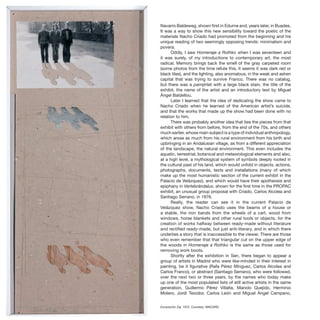


![PÁGINAS CENTRALES / CENTRAL PAGES · ARTECONTEXTO · 135
the Imágenes de la abstracción catalog.
“We realized that the artistic space
took on a different dimension, it could
express new relationships and produce
new considerations about practicing art,
bringing about a certain fusion between
trends up until then considered opposite
if not opposed.”
The documentation and set up of
the show were important when it came
to achieving that unity of the diverse
that the artists and curator were after.
Alcolea hung illustrative photos of
different trips and another of a water
reservoir, Becher style. Criado hung
images of a trip down the Guadalquivir
River, and Serrano photos of his studio,
with tools for painting piled on the table,
and an enlarged reproduction of a 1971
sketch book. The lighting, in which Utray
collaborated, concentrated only on the
pieces, leaving the space around them in
opaque shadow, and the large horizontal
extension of Vertebrándalus’ tributaries
extended across the floor and crossed in
front of the works.
Those two years of 1976 and
1977 were especially fast and intense.
That said, as the reader will appreciate, without entering into the
fluctuating and at times bloody political situation at the beginning
of the Transition.
Within a few months fundamental changes in the media were
taking place. The newspaper “El País” appeared, as well as different
art publications, among them “Artefacto” and “Humo.” Television
art programs began, “Trazos,” and later “Imágenes,” managed by
Paloma Chamorro, which were an authentic media platform for the
new artists. Institutional exhibitions that had been unthinkable a few
years prior took place, such as En la Pintura in the Palacio de Cristal,
which aspired to be the point of affirmation of the political and
aesthetic reductionism in abstraction but was the swan song of the
theoretical model and the beginning of the dissolution of the group
“Trama,” publicized by Federico Jiménez Losantos and Tàpies, or
the exhibition in Alicante, which I coordinated and to which I will
make broader reference later. Spain occupied the Central Pavilion
of the Giardini in 1976 in the Biennale of Venice with an exhibit
organized by Simón Marchán, Tomás Llorens and Alberto Corazón,
Vanguardia artística y realidad social, which unleashed a sometimes
brutal controversy, in which those of us concerned with Spanish art,
cultural life and politics intervened. Several of Franco’s official centers
were legally occupied, like the Universidad Internacional Menéndez
Pelayo, Universidad de Santander, where the course La vanguardia
¿mito o realidad? took place, run by Antonio Bonet-Correa, with the
participation of international artists, historians and critics, among
them Corrado Maltese and Marcelin Pleynet, and which marked the
definitive transactional bridge between the current discourses of the
latest generation of the dictatorship and those which had risen in the
years we have been analyzing.
Alcolea, Criado, Serrano, Alaminos, Utray and, as I mentioned,
I, acting as coordinator (the word comisario (curator) was disliked for
its common association with the police [translator’s note: comisario
in Spanish also means police inspector]) were the nucleus from
which the exhibition arose, which took place in March 1977, in the
Caja de Ahorros de Alicante y Murcia exhibit space, and which was,
really, an enlargement of the concepts and criteria which had guided
the PROPAC. In this case we put together works by Nacho Criado,
Carlos Alcolea, Eva Lootz, Miquel Navarro, Juan Navarro Baldeweg,
Santiago Serrano, Javier Utray and Valcárcel Medina.
In my March 25, 1977, “El País” article, where I denounce
the censure undergone by Javier Utray’s piece (censorship was
legal at that time, today it is practiced illegally but from the same
power sources), one can read what his intention and objectives
were: “… an exhibit which attempts to flee from the characteristics
which surround the “group shows,” applying a methodology of
work according to which the different pieces of the show created
Paisajes endémicos, 1997-2003. Particular Collection. Photo: Joaquín Cortés/Román Lorés. Courtesy: MNCARS.](https://image.slidesharecdn.com/artecontexton34-35-220304081201/85/Artecontexto-n34-35-135-320.jpg)






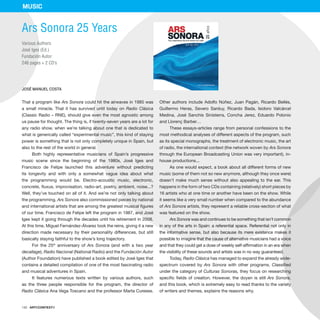



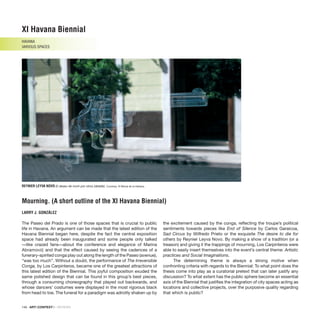





![152 · ARTECONTEXTO · CRÍTICAS
Mientras que en Alemania la 7ª Bienal de Berlin celebra un activismo
político a cuenta de la dimensión estética, la Bienal europea Mani-
festa echa un vistazo al pasado político-social y al futuro global. El
lugar donde se lleva a cabo es la mina en desuso de Waterschei (en
la región belga de Limburgo), que antiguamente fue un centro minero
especialmente importante. La única Bienal nómada europea, instala-
da en las viejas construcciones art deco abandonadas, bajo el título
The Deep of the Modern [La profundidad de lo moderno] –comisariada
por Cuauhtémoc Medina, en la dirección, junto a Katerina Gregos y
Dawan Ades– aborda aspectos como la herencia cultural de la moder-
nidad y la historia del lugar, que ejemplifica el impacto de la revolución
industrial.
Y para ello se ha integrado a una serie de iconos de la
modernidad, como Richard Long, David Hammons, Robert Smithson,
Marcel Broodthaers –con su Trois tas de charbon (1966-67)– o Marcel
Duchamp –con Twelve Hundred Coal Bags Suspended from the Ceiling
over a Stove (1938)– que así reunidas parecen constituir una historia
del arte moderno que se declina a base de carbón. La negra historia
de las minas y su contexto industrial se encuentra en un white cube
en el que se integran cuadros, fotografías y dibujos de los siglos XIX y
XX para hablar de las transformaciones sociopolíticas que conllevó la
revolución industrial. En muchas de las piezas aparecen vinculaciones
con el mundo minero –en otras no tanto–, caso de los dibujos de Henry
Moore o las fotografías en blanco y negro de escenarios mineros
marcados por la polución, pero con juegos fascinantes de luces y
sombras, que realizó en 1930 el fotógrafo de prensa estadounidense
William Rittase.
Las propuestas actuales de otros 35 artistas se diseminan por
el viejo recinto logrando no convertirse en víctimas de la energía del
histórico edificio. En una de de las zonas de las antiguas oficinas Raqs
Media Collective sincroniza en una doble proyección imágenes poé-
ticas y documentales en su pieza The Capital of Accumulation (2010)
donde intercalan citas del ideario de Rosa Luxemburg sobre la expan-
sión del capitalismo. Marge Monko, de Estonia, mezcla en sus imáge-
nes de trabajadoras de una fábrica textil fragmentos dramáticos de la
autora austríaca Elfriede Jelinek. El vídeo, que aparece ampliamente
representado, utiliza en muchos casos la estrategia de reconstrucción
de acontecimientos históricos.
Notable impacto ejerce, con su claro mensaje de denuncia, la
pieza del belga Maarten Vanden Eynde titulada Plastic Reef, inte-
grada por basura y vertidos plásticos extraídos del mar. Entre las
instalaciones de sonido –también numerosas– destaca la de Kuai
Shen que trabaja con colonias de hormigas, encerradas en recipientes
transparentes, y a las que se escucha pues sus movimientos, que se
asemejan a un rasgueo de guitarras electrónicas, son amplificados
por altavoces. En las salas y sus alrededores se escucha de vez
en cuando la Internacional, que emite un reloj de música integra-
do en la instalación del croata Nemanja Cvijanović, convertida en la
banda sonora de esta edición de Manifesta y a la que proporciona
el componente político y nostálgico que comparten muchas de las
obras seleccionadas. Surge aquí la interrogación de si desde estos
planteamientos, junto a la metáfora de las profundidades mineras,
podemos analizar los acontecimientos actuales o si, como señala
Cuauhtémoc Medina: «No podemos sentir verdadera nostalgia de la
modernidad, pues no es “nuestra antigüedad”, ya que sigue forman-
do parte de nuestro presente».
Manifesta 9
GENK (LIMBURGO)
MINA DE WATERSCHEI
UTA MARIA REINDL](https://image.slidesharecdn.com/artecontexton34-35-220304081201/85/Artecontexto-n34-35-152-320.jpg)







![160 · ARTECONTEXTO · CRÍTICAS
Forget Fear [Olvida el miedo] es el título de la 7ª Bienal de Berlín,
con el artista polaco Artur Żmijewski como director artístico, y Joanna
Warsza y el colectivo de activistas radicales rusos Voina como
curadores asociados. Organizada por el Kunst Werke Institute for
Contemporary Art, tiene lugar en espacios de la ciudad como el edificio
y patios del KW, Akademie der Künste, KuLe e.V., St. Elizabeth-Kirche,
Deutschlandhaus y Friedrichstrasse 226, con una carga ideológica que
propone la transformación de los procesos sociales, la destrucción del
sistema artístico/mercantil y la “ocupación” del espacio público por una
cultura activa, colectiva y comprometida con los problemas urgentes
de la sociedad. La idea de que la obra de arte es un instrumento político
para cambiar el mundo (y no un objeto de contemplación estética) es
evocada por Voina, quien reclama «un arte real = un arte armado».
Sin embargo, los objetivos revolucionarios de estas consignas en el
contexto institucional de la Bienal como “campo de batalla” resultan
poco convincentes, cuando no ingenuas. En la organización del Foro
prevalece una fenomenología de la revolución formalizada como cita
histórica y “programa” de intenciones ideológicas más que un cambio
real en las estructuras del poder.
La excesiva instrumentalización curatorial con su aparato de re-
ferencias “revolucionarias” sitúa la Bienal en una resistencia forzada,
un espectáculo de la revuelta o el laboratorio de pruebas de una inte-
lligentsia autoconsiderada radical que corre el riesgo de banalizar la
lucha activista y los fenómenos sociales en pro de la provocación y,
en su desprecio del arte no considerado adecuadamente “político”, se
arroga la exclusión en el debate de los propios artistas o, como en el
caso del proyecto Open Call, su determinación expositiva en archivos.
Para Voina «las exposiciones de arte contemporáneo son dañinas. (...)
Por lo tanto, cuantas menos obras de arte haya en la Bienal mejor».
Antes que ajustar proyectos existentes, Żmijewski ha convo-
cado a asociaciones activistas, movimientos sociales y grupos po-
líticos, mientras que Joanna Warsza propugna “la lógica del perio-
dismo” en la elección de las obras, enfocando las imágenes de los
acontecimientos sociopolíticos en el mundo. Así, han sido invitados
revistas como Krytyka Polityczna, el JRMiP, activistas de movimien-
tos de protesta de Frankfurt, New York, Londres y Amsterdam, 15M/
Indignados, ¡Democracia Real YA!, Echte Demokratie Jetzt! y de la
Primavera Árabe, realizando plataformas de discusión (asam-
bleas, talleres, proyecciones y acciones) en el “gran no-pro-
yecto” OCCUPY Biennial, con la “acampada” en el KW, don-
de los activistas están “descontextualizados” por la simulación y
recopilación de un “material revolucionario” de imágenes, pintadas
y consignas (diría Baudrillard, trás mayo del 68, “folcklórica”). Sim-
bólica es la tras/locación al patio del KW de la Llave del Retorno
del campo de refugiados palestinos Aida Refugee Camp, y especial
atención merecen los proyectos ArtWiki, Breaking the News o New
World Summit, de Jonas Staal.
La Bienal plantea, además, debates y proyecciones sobre la me-
moria histórica, las migraciones y la transformación política del espacio
público en las “Acciones de solidaridad”, con la participación de institu-
ciones polacas, italianas y suizas, entre las que destaca el proyecto del
grupo Public Movement. Por su parte, artistas como Joanna Rajkows-
ka, Pawel Althamer, Teresa Margolles, Antan Mockus, Lukasz Surowiec,
Marina Napruskina y el propio Żmijewski, entre otros, son reducidos a
la operatividad política de una obra que, en su respuesta a los objetivos
curatoriales, resulta sólo “revolucionariamente correcta”.
7ª Bienal de Berlín
BERLÍN
VARIOS ESPACIOS
PIEDAD SOLANS](https://image.slidesharecdn.com/artecontexton34-35-220304081201/85/Artecontexto-n34-35-160-320.jpg)



![164 · ARTECONTEXTO · CRÍTICAS
A Living Man Declared Dead and Other Chapters I-XVIII [Un hombre
vivo declarado muerto y otros capítulos I-XVIII] da origen y título a
la última serie de trabajos de Taryn Simon. Elaborada a lo largo de
cuatro años, en los que la artista ha rastreando y documentando lina-
jes familiares y sus historias relacionadas por todo el mundo, Simon
transciende en ella el hecho anecdótico que documenta para desvelar
las tensiones inherentes entre lo personal y el poder político y social.
Las narrativas personales aparecen así afectadas por fuerzas exter-
nas –circunstanciales, sociales, religiosas o políticas– más allá de la
herencia genética, psicológica o emocional.
En trabajos anteriores, como The Innocents o An American Index
of the Hidden and Unfamiliar, Simon había catalogado hechos invero-
símiles (inocentes sentenciados a largas condenas o elementos aleja-
dos de la mirada pública americana) de un modo aparentemente ex-
haustivo. La búsqueda de un elenco absoluto que no tuviera la nece-
sidad de editar le ha llevado, en esta ocasión, a los lazos sanguíneos
–nueve de los cuales se muestran en el MoMA hasta septiembre.
Cada trabajo de la serie se organiza en tres fragmentos. El pri-
mero consta de los retratos de los miembros del linaje a documentar.
Organizados de forma sistemática, incluyen a los ascendentes y des-
cendentes vivos de un individuo concreto. Los retratos vacíos repre-
sentan a familiares que no pudieron ser fotografiados por diversas
circunstancias (prisión, impedimento religioso o social, enfermedad,
etc.). El segundo recoge la narración de la historia familiar, mientras
que el tercero, organizado de un modo abstracto e intuitivo, contiene
evidencias fotográficas de lo narrado. Es en el ir y venir entre el texto y
la imagen, en ese espacio invisible entre los paneles, donde emerge el
significado y se construye la historia final. A su vez se reflexiona aquí
sobre la posibilidad del archivo de conectar la identidad y la memoria
personal con la historia.
Así, por ejemplo, el trabajo que origina la serie documenta a los
descendientes vivos de un hombre fallecido en la India. Desposeídos
de sus tierras, tras ser declarados muertos mediante el soborno a las
autoridades llevado a cabo por familiares lejanos, reclaman su estatu-
to de “vivos” desde el año 2001.
El capítulo VII se centra en la matanza de ocho mil musulmanes
bosnios en Srebrenica. Simon documenta un linaje donde los cuatro
hijos varones fueros exterminados. Es la única pieza en la que se re-
presenta a individuos muertos –a través de restos de dientes y huesos
utilizados para su identificación– incluyendo el esqueleto completo de
uno de los asesinados.
El capítulo XVII se centra en los niños de un orfanato ucraniano;
el III en las nueve esposas de un médico keniata; el XI en la familia de
Hans Frank, consejero de Hitler y gobernador de la Polonia ocupada;
el VI documenta tres líneas sanguíneas de conejos en Australia, inocu-
lados con virus letales con el fin de controlar su prolífica reproducción.
Y así hasta dieciocho historias que transcienden lo personal.
Efectivamente, en las narrativas que cataloga, Simon busca pa-
trones, episodios arquetípicos que ocurrieron en el pasado y que son
susceptibles de repetirse. Quizá sea por eso que el trabajo se organice
en una precisa estructura de retratos uniformes, realizados sobre un
fondo neutro y desde el mismo punto de vista. Hay en la disposición
reticular de la serie y en su vastedad una referencia a lo que una y otra
vez se repite y a lo inacabado, a la dificultad de abarcar la existencia
humana –cuyas historias, sin embargo, son susceptibles de emerger
indefinidamente.
Taryn Simon
Nueva York
MUSEUM OF MODERN ART (MoMA)
LAURA F. GIBELLINI](https://image.slidesharecdn.com/artecontexton34-35-220304081201/85/Artecontexto-n34-35-164-320.jpg)








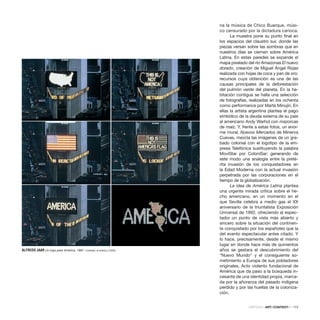


![176 · ARTECONTEXTO · CRÍTICAS
¿Puede una obra de arte rigurosa, estricta, resultar divertida? Si nos
atenemos a lo que está sucediendo desde que Ryoji Ikeda plantó su
gran instalación data.tecture [5 SXGA+ version] en LABoral de Gijón,
la pregunta puede ser respondida de inmediato. Sí.
Describir data.tecture es relativamente sencillo. Imagine-
mos un rectángulo de 7 por 25 metros, sobre el que cinco vídeo-
proyectores cenitales dibujan columnas de datos digitales que se
mueven en longitud y cambian siguiendo una secuencia marcada
por un tono más agudo.
No hace falta anotar que data.tecture ocupa casi por com-
pleto una de las enormes naves de LABoral, pero sí que se ha
realizado una especie de balcón, a unos siete metros del suelo,
desde el cual se puede contemplar la obra desde una perspec-
tiva diferente.
Pero lo interesante sucede a ras de suelo. Siguiendo ins-
trucciones de Ikeda, los espectadores son libres para entrar en la
obra (descalzos) y la mayor parte hacen buen uso de esa oportu-
nidad, corriendo arriba y abajo siguiendo las secuencias alfanu-
méricas, jugando a una especie de mega tres en raya, quedando
extasiados bajo los proyectores, contraponiendo su velocidad de
desplazamiento a la de los datos… La música, parte integral y
originaria en todas las obras de Ikeda, ayuda a romper esa idea
del No Decir-No Tocar-No Pisar que permea todos los museos
habidos y por haber.
Data.tecture, una evolución de la serie Datamatics, tiene
que ver con el funcionamiento erróneo de discos duros e incluye,
según nos informa Ikeda, «transformaciones, visualizaciones y
sonificaciones (sic.) de una gran cantidad de datos científicos,
RYOJI IKEDA
GIJÓN
LABORAL CENTRO DE ARTE y creación industrial
Zen digital
JOSÉ MANUEL COSTA
datamatics. data.tecture [5 SXGA+ version]. Foto: Marcos Morilla. Cortesía: LABoral.](https://image.slidesharecdn.com/artecontexton34-35-220304081201/85/Artecontexto-n34-35-176-320.jpg)
![CRÍTICAS · ARTECONTEXTO · 177
como ADN del genoma humano, coordenadas astronómicas de
estrellas en el universo, estructuras moleculares de proteínas e,
incluso, datos de la propia arquitectura de Datamatics». Todo esto
plantea cuestiones de orden filosófico que bordean lo místico. Te-
niendo en cuenta que Ikeda se define a sí mismo como un artista
industrial, el salto hacia lo trascedente mediante lo digital no es
menor y es una de las razones por las que su trabajo, que podría
resultar casi clínico y deshumanizado, lleva tocando desde hace
mucho la fibra sensible y no solo intelectual de quienes han con-
frontado su obra.
El responsable de LABoral, Benjamín Weil, establecía una
relación entre data.tecture y un jardín zen japonés. Cabe imagi-
nar que estaba pensando en el de Ryoan-ji, el más famoso de los
jardines secos nipones, realizado a finales del siglo XV y que se
encuentra en Kyoto, donde Ikeda tiene su vivienda en Japón (ha-
bitualmente reside en Paris). En este jardín, cuyas medidas son
semejantes a data.tecture (10 x 25 metros), hay 15 piedras sobre
un mar de arena distribuidas de tal manera que resulta imposi-
ble para el espectador contemplarlas todas al mismo tiempo, se
sitúe donde se sitúe. La idea rectora de este jardín consiste en
la incapacidad humana para aprehender cualquier cosa en su
totalidad.
Y esto es también lo que plantea Ikeda. No hay manera hu-
mana de contemplar de una vez todos los matices de data.tecture
[5 SXGA+ version], tanto por el movimiento, como por la escala
de los datos alfanuméricos, como por las mismas dimensiones
de la obra. Este reconocimiento de nuestra incapacidad genera
una política del auto-cuestionamiento tanto individual como so-
cial, pero no se presenta disociado de una política del placer. Es
más, el juego de las personas no solo no disminuye la potencia de
la intención última, sino que la aumenta: cuando alguien disfruta y
sonríe, es difícil que olvide. Y no olvidar es también pensar.
datamatics [prototype-ver.2.0], 2006. © Ryoji Ikeda. Foto: Ryuichi Maruo. Cortesía: Yamaguchi Center for Arts and Media (YCAM).](https://image.slidesharecdn.com/artecontexton34-35-220304081201/85/Artecontexto-n34-35-177-320.jpg)
![178 · ARTECONTEXTO · REVIEWS
Can a strict and precise work of art be fun? If we go by what is
happening since Ryoji Ikeda set up his immense installation data.
tecture [5 SXGA+ version] in Gijón’s LABoral, the answer is an
immediate yes.
To describe data.tecture is relatively simple. Imagine a 7 x
25 meter rectangle upon which five video projectors, suspended
from the ceiling directly above, draw columns of digital data which
move longitudinally and change according to a sequence with a
high-pitched tone.
No need to note that data.tecture takes up nearly one of
the entire warehouse-sized spaces at LABoral, and they have
constructed a type of balcony about seven meters off the floor so
the piece can be viewed from a different perspective.
But the most interesting part of it happens at floor level.
Following Ikeda’s instructions, viewers are free to enter the
artwork (barefoot) and most people do so, running up and down
the alphanumeric columns, playing a type of giant tic-tac-toe in
line, stopping captivated beneath the projectors, trying to move
as fast as the data…The music, an essential and original part of
all of Ikeda’s works, helps to break that idea of Don’t Speak-Don’t
Touch-Don’t Step On which permeates all museums now and
forever.
Data.tecture, an evolution of the series Datamatics, is related
to the erroneous functioning of hard drives and includes, as Ikeda
tells us, “transformations, visualizations and sonifications (sic.)
of a large amount of scientific data, such as human genome
DNA, astronomic coordinates of stars in the universe, molecular
structures of proteins and even data from the architecture of
Datamatics itself.” This brings up philosophical questions which
border on the mystical. Bearing in mind that Ikeda defines himself
RYOJI IKEDA
GIJÓN
LABORAL CENTRO DE ARTE y creación industrial
Digital Zen
JOSÉ MANUEL COSTA
datamatics. data.tecture [5 SXGA+ version]. Photo: Marcos Morilla. Courtesy: LABoral.](https://image.slidesharecdn.com/artecontexton34-35-220304081201/85/Artecontexto-n34-35-178-320.jpg)
![REVIEWS · ARTECONTEXTO · 179
as an industrial artist, the leap toward
the transcendental via the digital is no
small feat, and is one of the reasons his
work, which might seem almost clinical
and dehumanized, has for a long time
touched not just the intellectual but
also the sensitive fiber of those who
have confronted it.
Benjamin Weil, the man in charge
of LABoral, establishes a relationship
between data.tecture and a Japanese
Zen garden. One can imagine that
Ikeda was thinking of Ryoan-ji, the
most famous dry Japanese garden,
created at the end of the 15th
century
and located in Kyoto, where Ikeda
makes his home when he is not in
his usual Paris. With measurements
similar to data.tecture’s (10 x 25
meters), Ryoan-ji contains15 rocks
on a sea of sand, distributed in such
a way that makes it impossible for
the spectator to view all of them at
once, regardless of where he stands.
The garden’s central idea lies in the
human incapacity to grasp anything
in its entirety.
This is also what Ikeda wanted.
With its movement, the amount of
alphanumeric data, as well as its
dimensions, there is no humanly
possible way to contemplate the
nuances of data.tecture [5 SXGA+
version] all at once. This recognition
of our incapacity generates a policy
of self-questioning both individually as
well as socially, but is not presented
separately from a policy of pleasure.
What’s more, people playing within the
piece not only does not diminish the
power of its objective, it increases it: it
is hard to forget somebody smiling and
enjoying himself. And not forgetting is
also thinking.
datamatics. data.tecture [5 SXGA+ version]. Photo: Marcos Morilla. Courtesy: LABoral.](https://image.slidesharecdn.com/artecontexton34-35-220304081201/85/Artecontexto-n34-35-179-320.jpg)










![190 · ARTECONTEXTO · REVIEWS
Talking about the crisis can already be considered an excessively
recurrent topic, mainly because during the last few years the media
has talked of little else. But what they’ve been telling us really
hasn’t helped people get a clear idea of the causes and effects of
what went on during the golden years of real estate speculation.
It seems like their objective is to spread a tale of fear intended to
paralyzed the largest possible number of people, so that no one
forgets, once again, that it’s better just to keep quiet.
The project Sistema fallido [System failure], curated by Javier
Marroquí and David Arlandis, provides the spectator with data,
using different mediums to present a re-reading of the information
that describes what happened during this “glorious” economic
period, and outlining some of its repercussions. As a side note, I
should mention the fact that my visit to this exposition coincided
with the very day that Rodrigo Rato announced his resignation as
the director of Bankia, while the Spanish government demonstrated
its willingness to continue injecting capital into the financial system,
and at the same time that the Health Minister of Extremadura
abolished evening hours for health clinics in this region and, due
to a conflict of interests with his office, was obliged to give up
his afternoon job as an ophthalmologist in Portugal. There is no
doubt that the system has failed. The problem is that this model
of failure has been integrated, to a greater or lesser extent, into
all layers of society. There was a time, only moments ago, when
people couldn’t understand those who were not accumulating or
speculating with properties. Almost everyone wanted their piece
of the pie, which is why it was very complicated for this extensive
network of interests to impose limits on that which was reasonable.
Without a doubt, the greatest failure falls to the politicians, with no
exception, who either didn’t want or didn’t know how to regulate
what was clearly a dazzling path towards the edge of the cliff.
It’s sometimes possible to hear or read commentaries by
people who can’t digest those artistic projects that, like those
presented by Juan José Martín and Oliver Ressler & Zanny Begg,
explicitly direct their attention towards questions of a political
nature. It seems that this still makes people uncomfortable. Some
people expect something else from art. In fact, in Valencia, there
are currently at least four expositions open to the public that
feature poetry in a dialogue with art. Naturally, all of these cases
involve a self-absorbed style of poetry and a self-satisfied art. This
is not what a visitor will find at Nymlab. This new, independent
exposition space has joined the dynamic of others like it in the
System Failure
VALENCIA
NYM_LAB
Facing it
JOSÉ LUIS PÉREZ PONT
OLIVER RESSLER & ZANNY BEGG The bull laid bear, 2012. Courtesy: NYM_lab.](https://image.slidesharecdn.com/artecontexton34-35-220304081201/85/Artecontexto-n34-35-190-320.jpg)



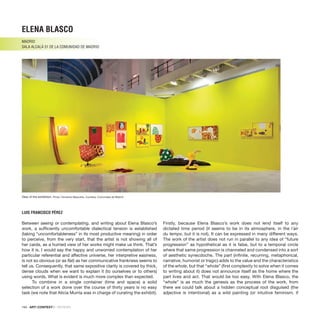
![REVIEWS · ARTECONTEXTO · 195
we want to be grave and serious), or a very unbalanced sculpture
in its relationship between shape and content, or an impetuous and
imprudent installation with its crazy use of color. Costumes, yes,
but also hidings of a longer order, like collars and masks which do
not let us see the true face of the action. Masks that on the one
hand show the declamatory drama of an intelligent and voluntarily
crazed aesthetic, while at the same time hiding the fine print of a
way to understand the artistic practice of a radicalism as cruel as it
is pious.
Millones y abundantes razones [Millions and Abundant Reasons]
is the title given by Elena Blasco to her panoramic exhibition in the
Sala Alcalá 31. There are no innocent or naïve titles, and this less so
than any. Millions and abundant reasons are what Elena Blasco offers
us to calibrate her own work, and the panorama is further enriched
when we use those millions of reasons to place the work within the
Spanish historical panorama of the last thirty years. Let’s look at just
one reason, which reminds me of a de época comment. How many
times in our adolescence and youth did we say that the song on
Side B of a 45 was better than the song on Side A, advertised as the
best, the one that was going to be a hit. Spain’s history of art since
the Transition is screaming for the reconsideration of many Side Bs
which the rush, ignorance, false modesty, complexes, obsession for
the no less false “international aesthetic,” and the “secondisms” of
certain authors and movements made not only an international, but
a national projection impossible for far from a few artists, among
them, of course, Elena Blasco. This is probably (at least for me) the
main reason for this exhibition, of such a necessary and admirable
raison d’etre.
View of the exhibition. Photo: Fernando Maquieira. Courtesy: Comunidad de Madrid.](https://image.slidesharecdn.com/artecontexton34-35-220304081201/85/Artecontexto-n34-35-195-320.jpg)




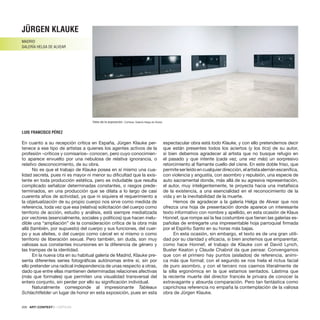



![204 · ARTECONTEXTO · CRÍTICAS
No cabe duda de que la proliferación de pantallas de
todo tipo es uno de los fenómenos más inquietantes de
nuestro tiempo, sobre todo por la omnipresencia que
está adquiriendo en nuestras vidas el poder de ese rec-
tángulo mágico que, desde el trabajo al ocio, pasando
por la información y las relaciones sociales, mediatiza y
condiciona tanto la vida cotidiana como la realidad per-
ceptiva y sustancial. Sin embargo, una las paradojas de
este fenómeno se encuentra en el hecho de que, a mayor
conciencia de la pantallización general del mundo, ma-
yor es, también, la dificultad de despegarse de la propia
influencia de las pantallas para conseguir una distancia
que nos permita hacer una reflexión serena sobre el fenó-
meno en cuestión. Las pantallas ocupan espacio, tiempo
y cerebro, podríamos decir.
Pues bien, tratar de facilitar esa distancia necesaria
es uno de los aspectos más relevantes del proyecto ex-
positivo Pantalla Global [Global Screen], una coproduc-
ción entre el museo San Telmo y el CCCB, que ya exhibió
la muestra este mismo año. El proyecto cuenta con tres
comisarios: el filósofo-sociólogo Gilles Lipovetsky, el es-
pecialista en cine y literatura Jean Serroy y el artista y
realizador Andrés Hispano.
Pantalla Global
BARCELONA
CCCB
SAN SEBASTIÁN / DONOSTIA
SAN TELMO MUSEOA
ALFONSO LÓPEZ ROJO
Pantalla Historia. © CCCB / Toni Curcó. Cortesía: CCCB.
Pantalla Política. © CCCB / José Antonio Soria. Cortesía: CCCB.](https://image.slidesharecdn.com/artecontexton34-35-220304081201/85/Artecontexto-n34-35-204-320.jpg)



















![224 · ARTECONTEXTO · CRÍTICAS
Resulta chocante encontrar en el EACC, uno de los pocos centros
públicos dedicados al arte actual en la Comunidad Valenciana,
una barca y unos utensilios de pesca. Pero no hemos de preocu-
parnos, no estamos ante otro cambio de rumbo cultural producido
por injerencia política –como en la Sala Parpalló, por ejemplo. Se
trata, al contrario, de un genial recurso de la exposición de la ar-
tista norteamericana Sharon Lockhart, que comisaría Neus Miró,
títulada Double Tide [Doble marea] y que presenta la pieza de ví-
deo homónima como eje central de la muestra. El trabajo consta
de dos proyecciones que registran el trabajo de la recogida de al-
mejas. Está rodado en Maine durante la estación estival, en la que
se dan dos mareas bajas, una al amanecer y otra al anochecer. El
resultado es un vídeo de 46’ que registra la recolecta durante el
amanecer y otro de 50’ durante el anochecer.
La pieza está en conexión directa con dos de sus últimos tra-
bajos Lunch Time y Exit. En los tres hay una fijación por el tiempo
del trabajo y su desconexión, el tiempo del descanso o el ocio.
Pero si en los anteriores trabajos la mirada se centra en el trabajo
industrial y masculino, Double Tide muestra trabajo realizado por
una mujer, Jen Cassad, en plena naturaleza. Se ve así la ruptura
del tiempo de la fábrica, creado por la sociedad industrial, y la
sumisión al tiempo de la naturaleza. A esta pieza bicanal la acom-
pañan dos fotos, una imagen conectada con la tradición pictórica
del bodegón, que muestra las almejas que se recolectan, que no
muestra el vídeo, y otra foto en la que vemos a una lugareña en su
tiempo de ocio en casa. Ambas imágenes muy pictóricas y toma-
das con cámara analógica y luz natural.
¿Qué demonios hacen estos objetos aquí? No es la primera
vez que la artista pone en juego este tipo de estrategias, como
mínimo, arriesgadas. Se trata de adecuar sus imágenes al espacio
de exposición, por un lado, y al entorno social, por otro. La arqui-
tectura, para Lockhart y Miró, ha de tenerse en cuenta al máximo
en una exposición, aún siendo una muestra que tiene como núcleo
central piezas de vídeo y fotografías, las cuales, en principio, se
adaptan perfectamente a cualquier arquitectura museística. Pero
ellas le dan una vuelta de tuerca mediante un trabajo de adapta-
ción tan complejo que bien deberíamos llamar asimilación.
Por un lado, en cuanto a lo físico, encontramos que la pieza
de vídeo bicanal se instala en una estructura, levantada para la
ocasión, que tiene casi la total longitud de la sala del EACC y que
SHARON LOCKHART
CASTELLÓN
ESPAI D’ART CONTEMPORANI DE CASTELLÓ (EACC)
JAVIER MARROQUÍ
Vista de la exposición. Foto: Jorge Wamba. Cortesía: EACC.](https://image.slidesharecdn.com/artecontexton34-35-220304081201/85/Artecontexto-n34-35-224-320.jpg)









